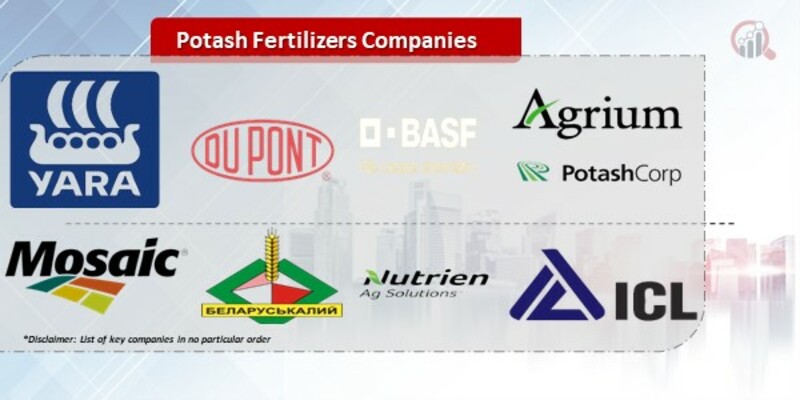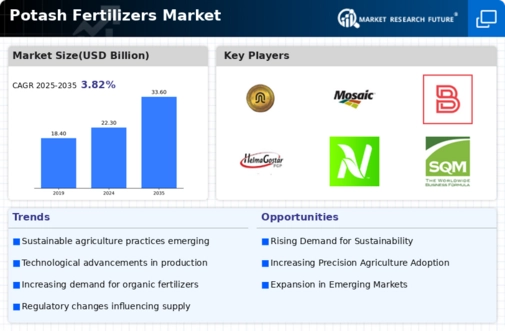Top Industry Leaders in the Potash Fertilizers Market
 The Potash Fertilizer Frenzy: A Landscape of Power, Innovation, and Uncertainty
The Potash Fertilizer Frenzy: A Landscape of Power, Innovation, and Uncertainty
The humble potash fertilizer, a source of lifeblood for crops, fuels a multi-billion-dollar market marked by intense competition, strategic maneuverings, and a growing demand for sustainable solutions. Understanding this landscape requires a deep dive into the key players, their strategies, and the factors shaping market share. Buckle up because the potash game is anything but boring.
Among the prominent players :
- Agrium Inc. (Canada)
- Yara International ASA (Norway)
- The Mosaic Company (U.S.)
- JSC Belaruskali (Republic of Belarus)
- Eurochem Group AG (Switzerland)
- Borealis AG (Austria)
- HELM AG (Germany)
- Sinofert Holdings Limited (China)
- Israel Chemicals Ltd. (Israel)
- Nutrien (Canada)
- K+S Aktiengesellschaft (Germany)
- SQM S.A. (Chile)
The Market Share Tango: Analyzing market share in the potash waltz requires a multi-faceted approach. Factors like production capacity, geographical reach, product portfolio, customer loyalty, and pricing strategies all play a crucial role. Additionally, government policies, environmental regulations, and global trade dynamics can significantly impact individual players and reshape the competitive landscape.
New Kids on the Block: Emerging players like Intrepid Potash and Koch Fertilizer LLC are adding a spicy twist to the competition. With innovative mining techniques and a focus on environmentally friendly practices, these newcomers are disrupting the traditional game. Intrepid's brine extraction technology holds promise for sustainable potash production, while Koch's focus on precision agriculture solutions addresses the growing demand for data-driven farming practices.
Investing in the Green Dream: With sustainability becoming a buzzword, companies are pouring investments into research and development of eco-friendly potash production methods and fertilizer alternatives. From exploring organic sources like seaweed to using recycled materials like fly ash, the quest for greener solutions is intensifying. This trend presents both opportunities and challenges for established players, potentially reshaping the competitive landscape in the years to come.
The Competitive Conundrum: The overall competitive scenario in the potash fertilizer market is a complex tapestry woven with established giants, agile challengers, and innovative newcomers. The dance between cost-effectiveness, sustainability, and technological advancements will determine the future winners and losers. Players who adapt to changing market dynamics, embrace innovation, and prioritize a greener future will stand to reap the rewards in this ever-evolving landscape.
Recent News :
New York, January 15, 2024: The potash fertilizer market, a crucial cog in the global food production machine, is sending mixed signals this month. While prices continue their downward trend, triggered by increased supply, concerns over potential disruptions and a rising focus on sustainable alternatives keep the industry on its toes.
Falling Prices, Cautious Optimism: After a rollercoaster ride in 2023, with prices peaking in the first half and then plummeting due to factors like the return of Belarus to the market and lower fertilizer affordability, potash prices have continued to dip in the new year. Analysts at CRU Group predict a further 5-10% decline by the end of Q1 2024, offering some relief to farmers battling high input costs. However, this downtrend also raises concerns about the profitability of producers, particularly smaller players.









